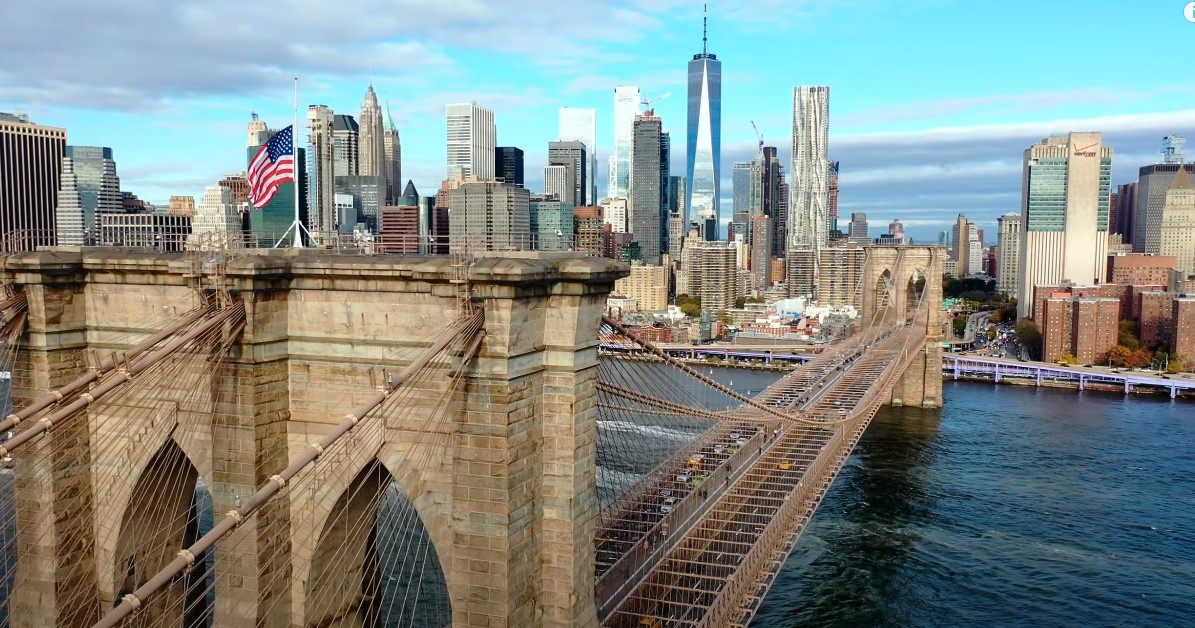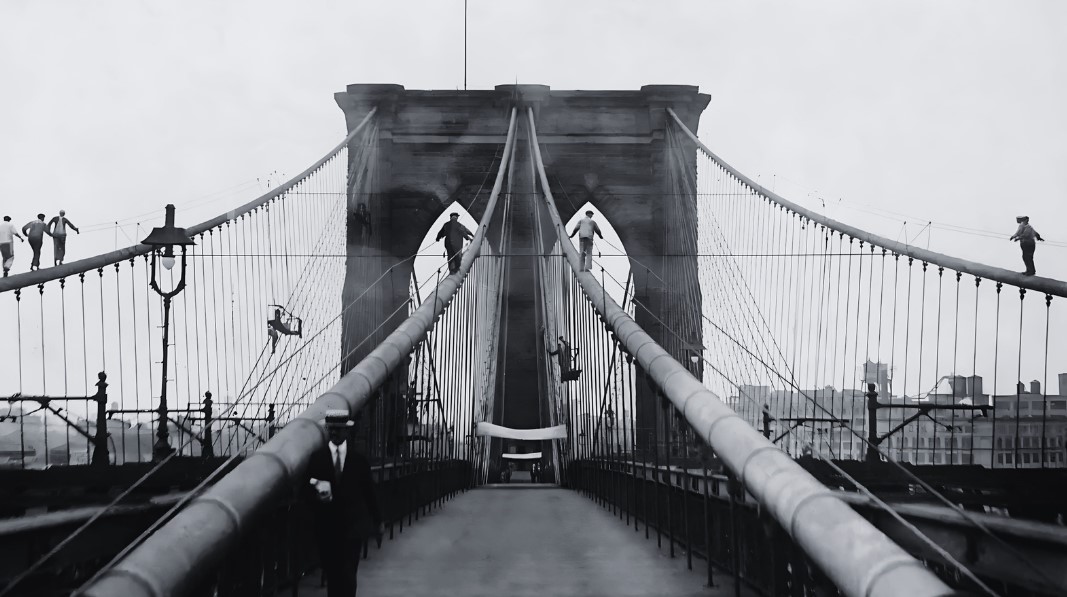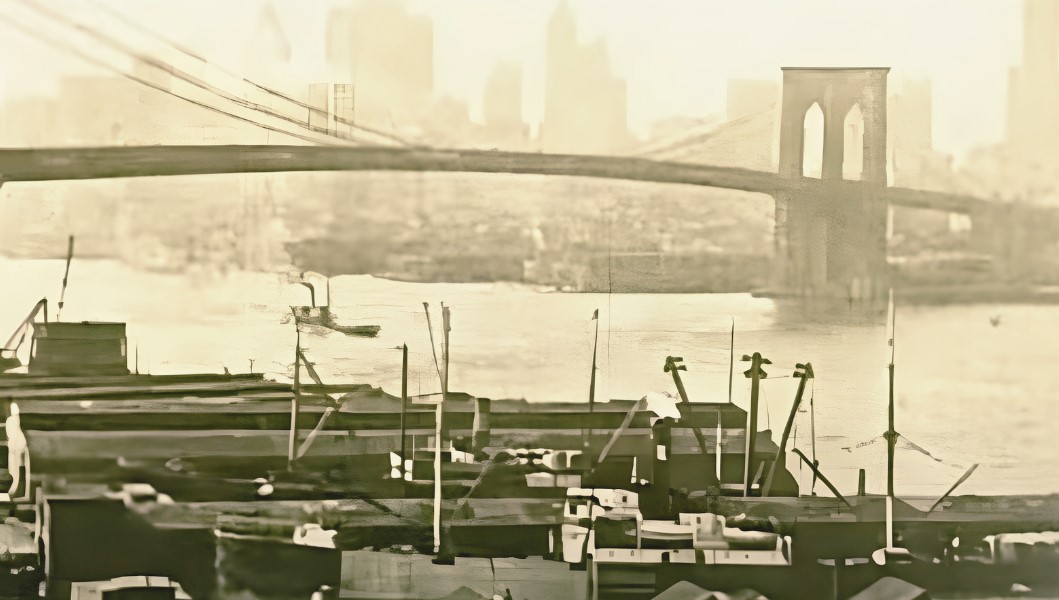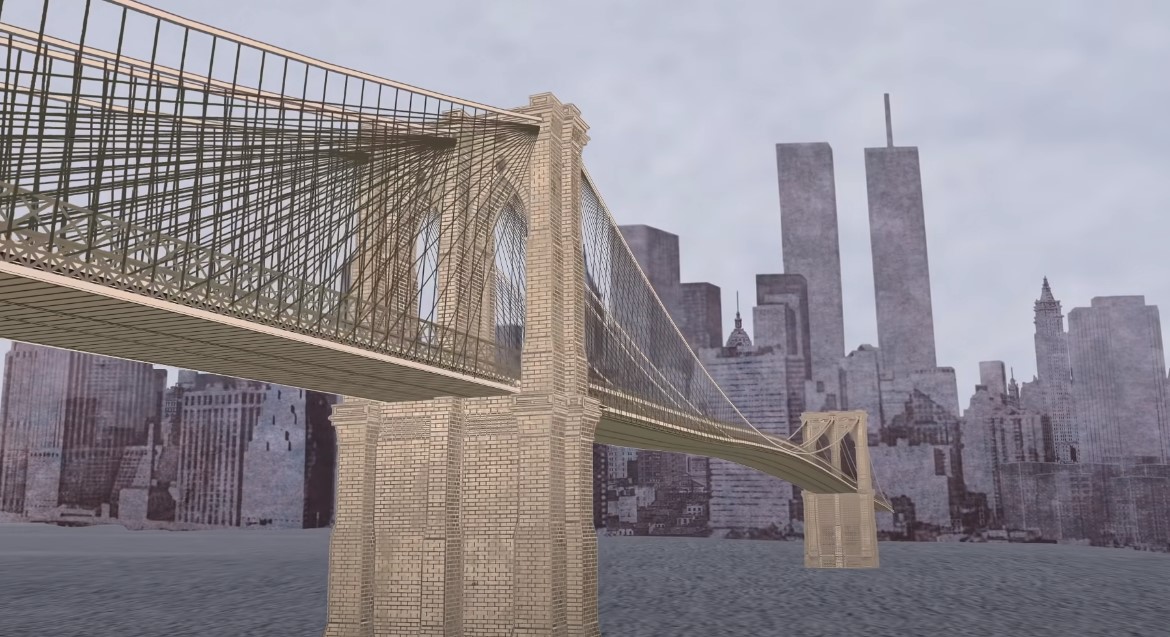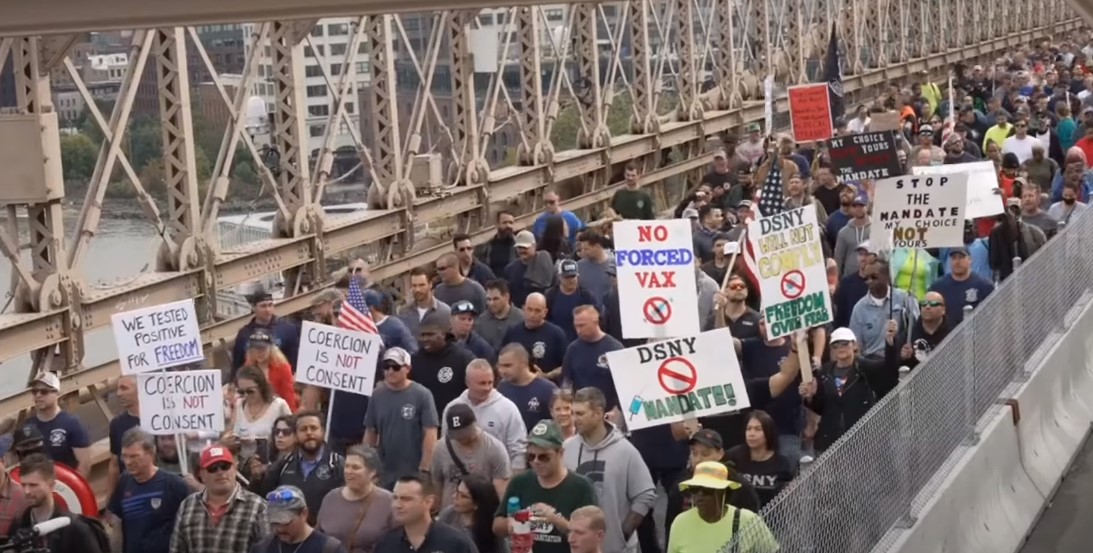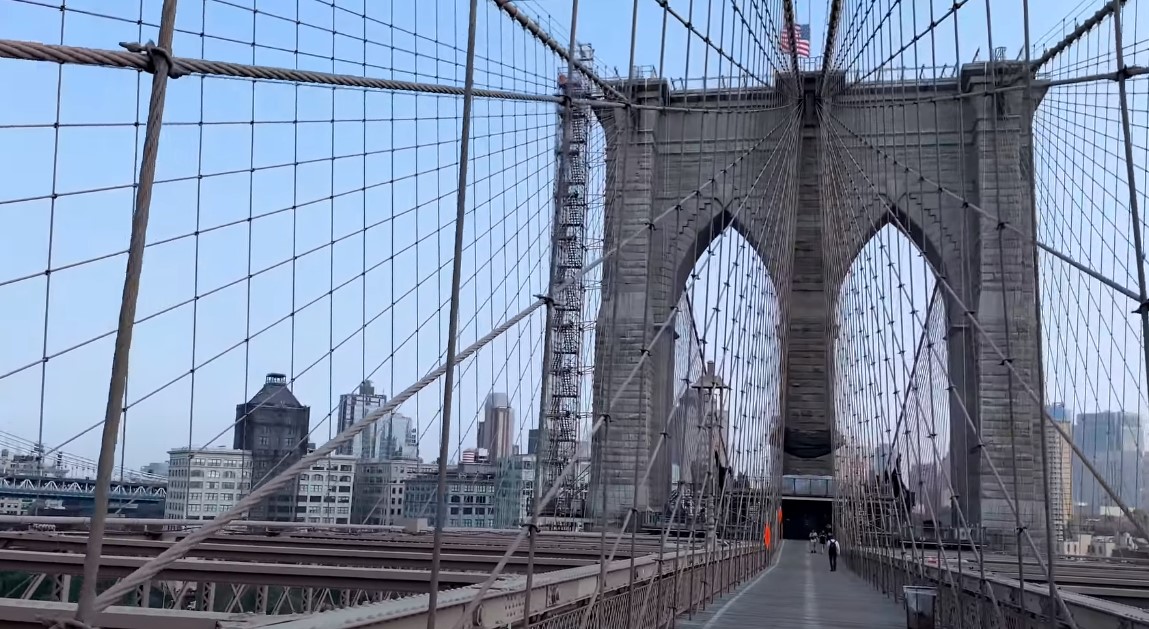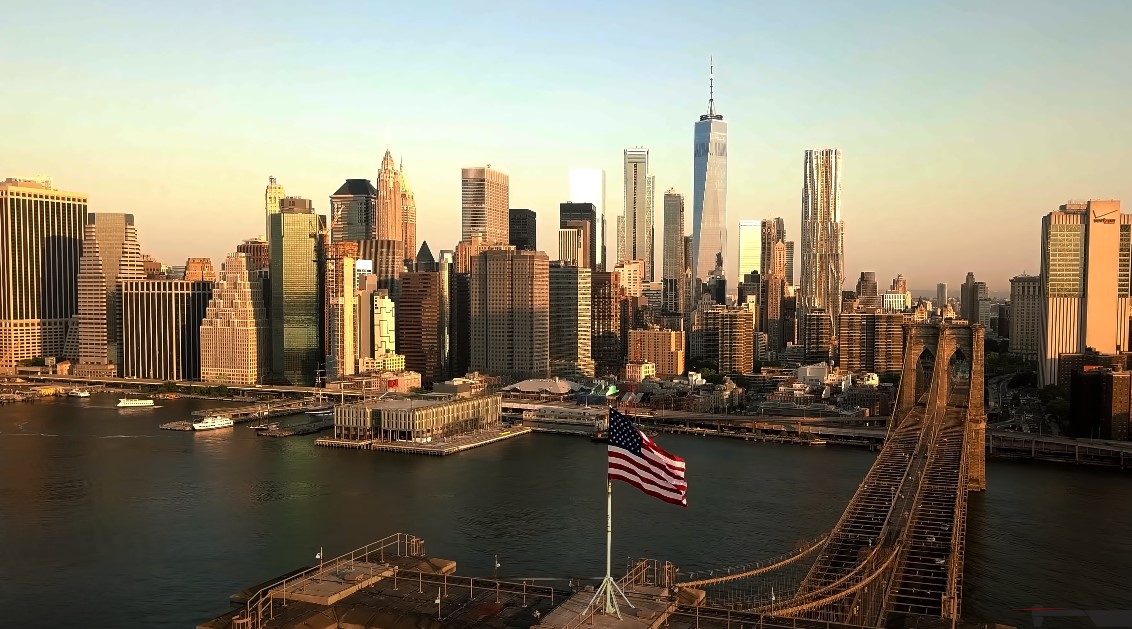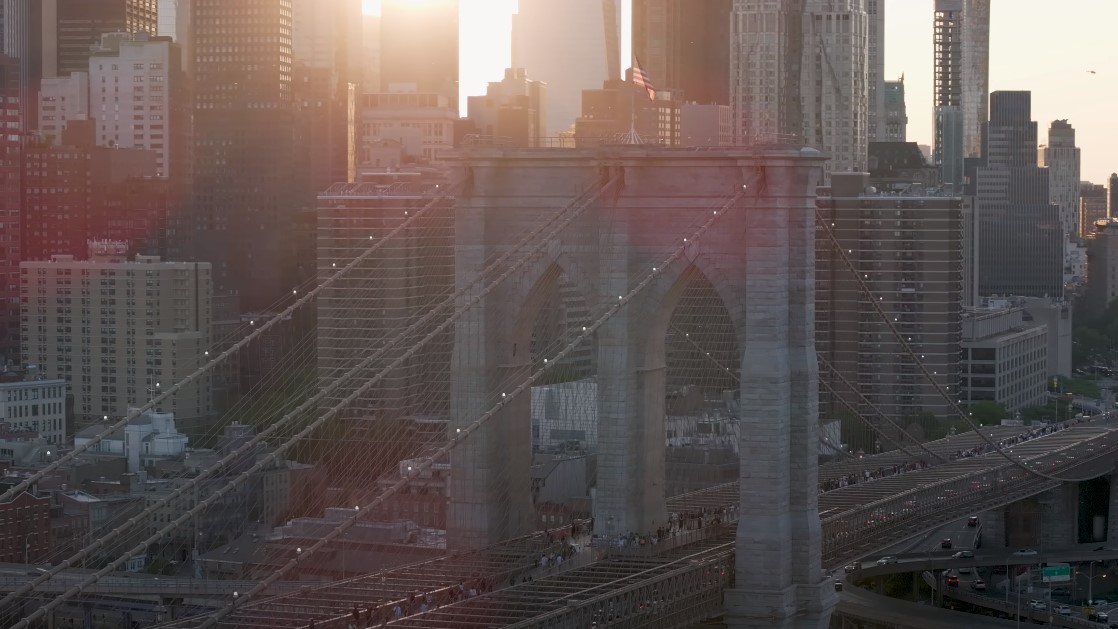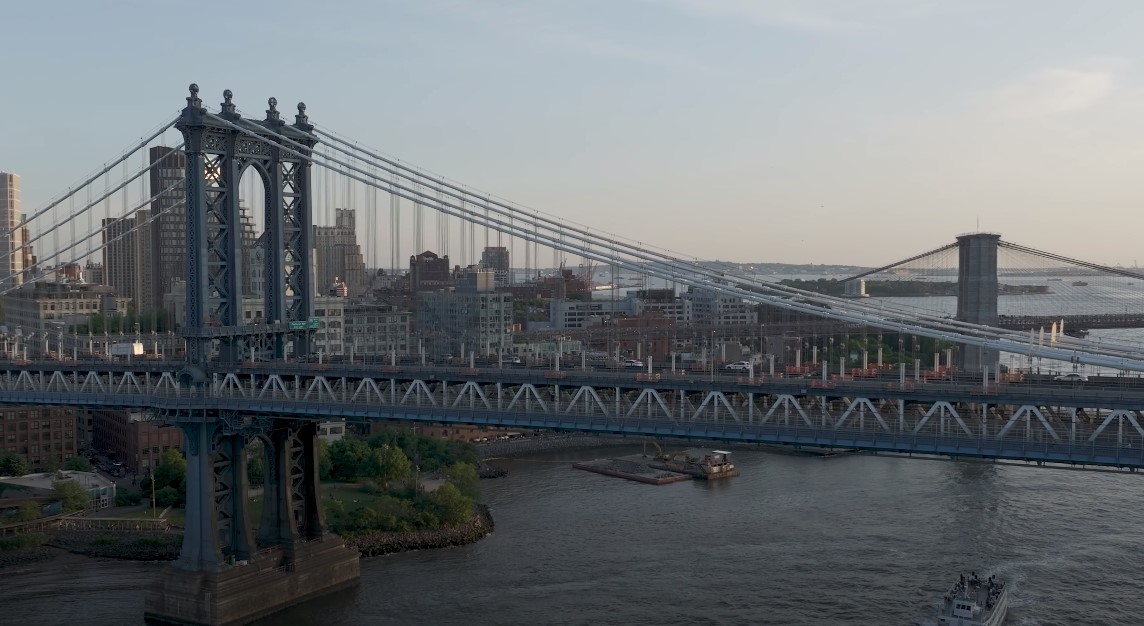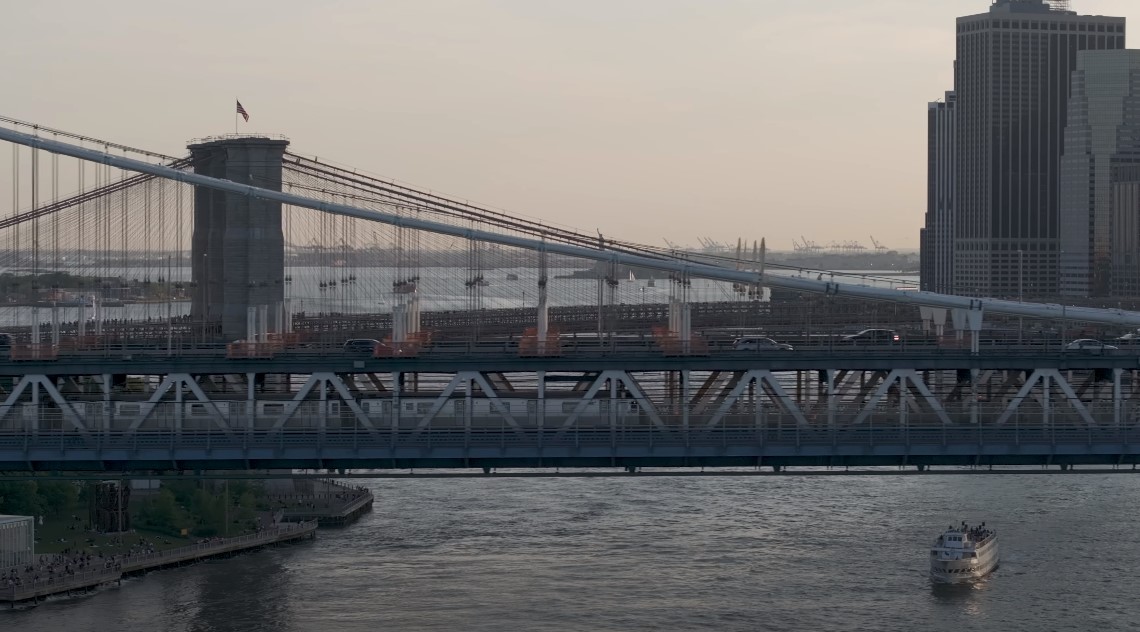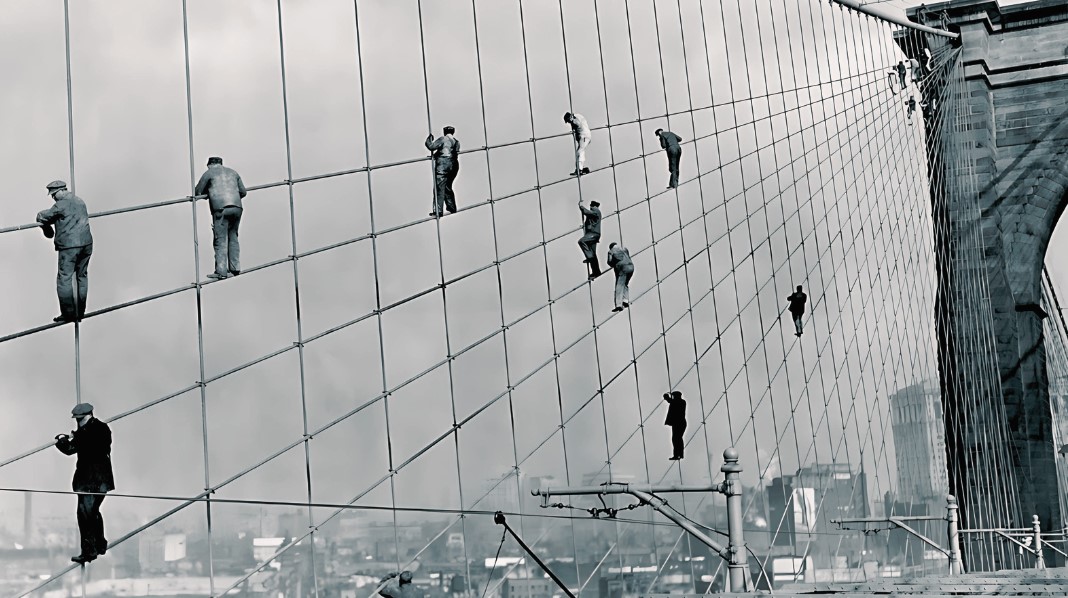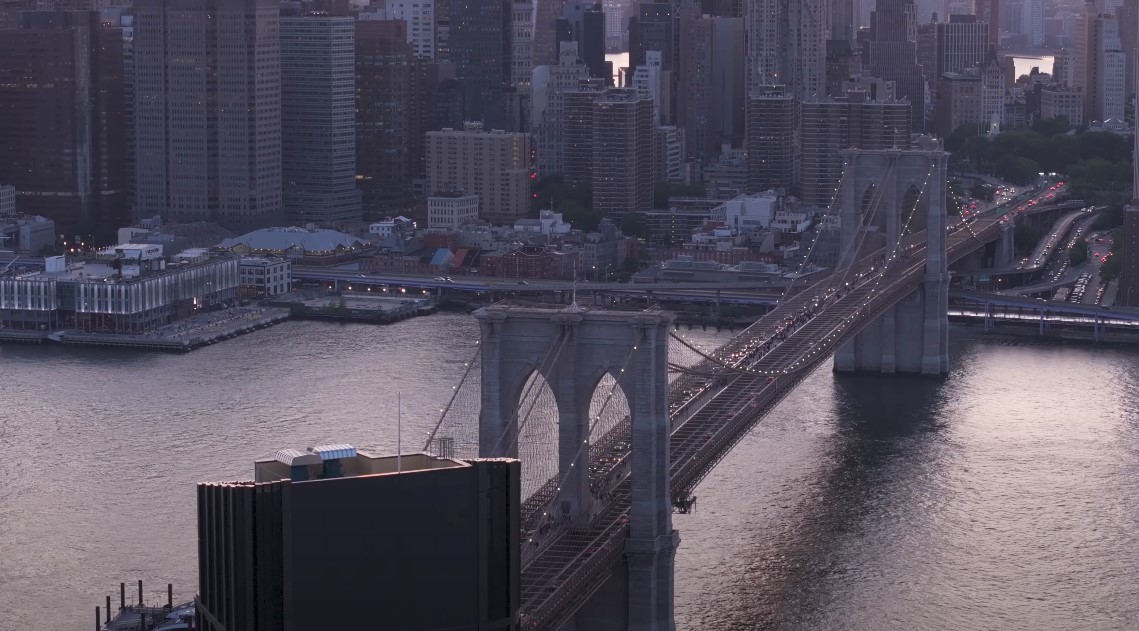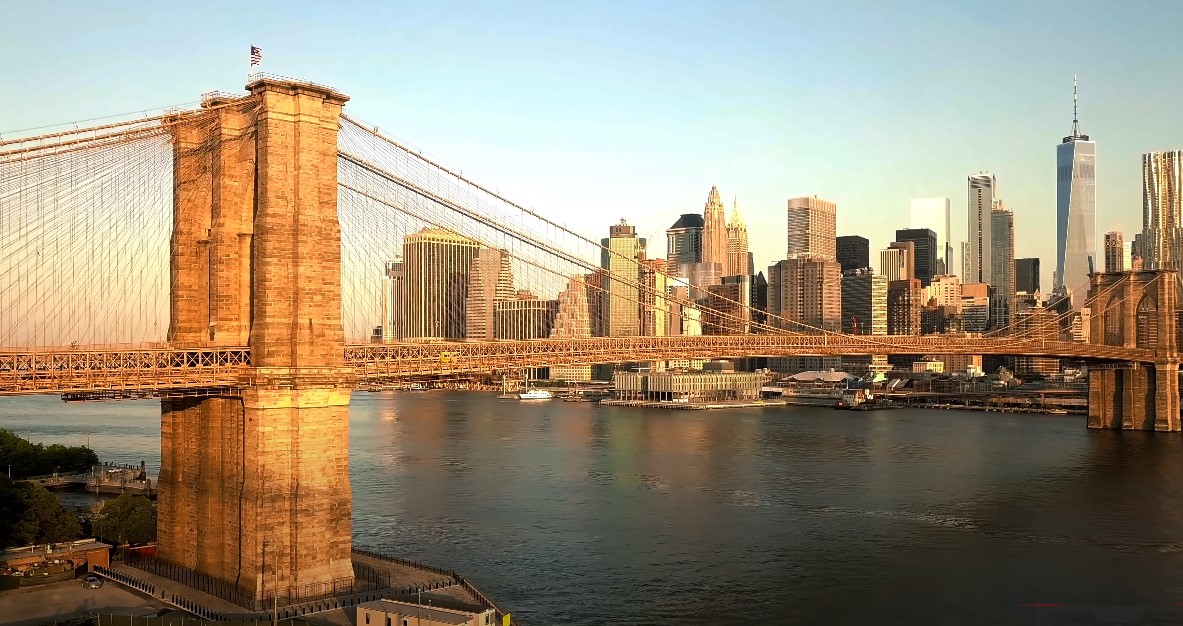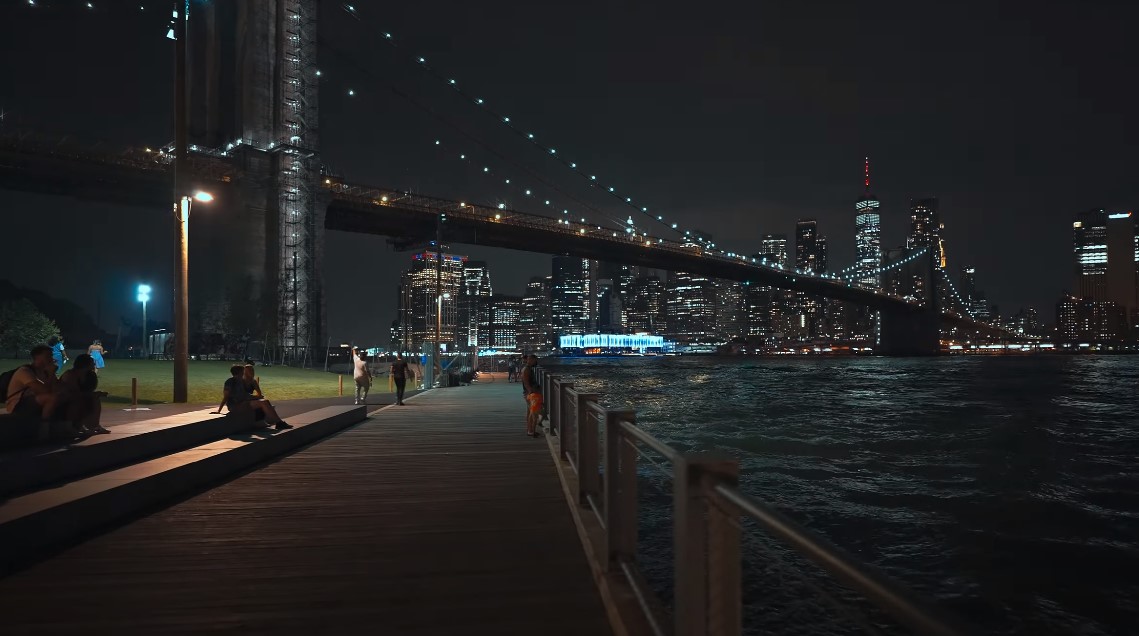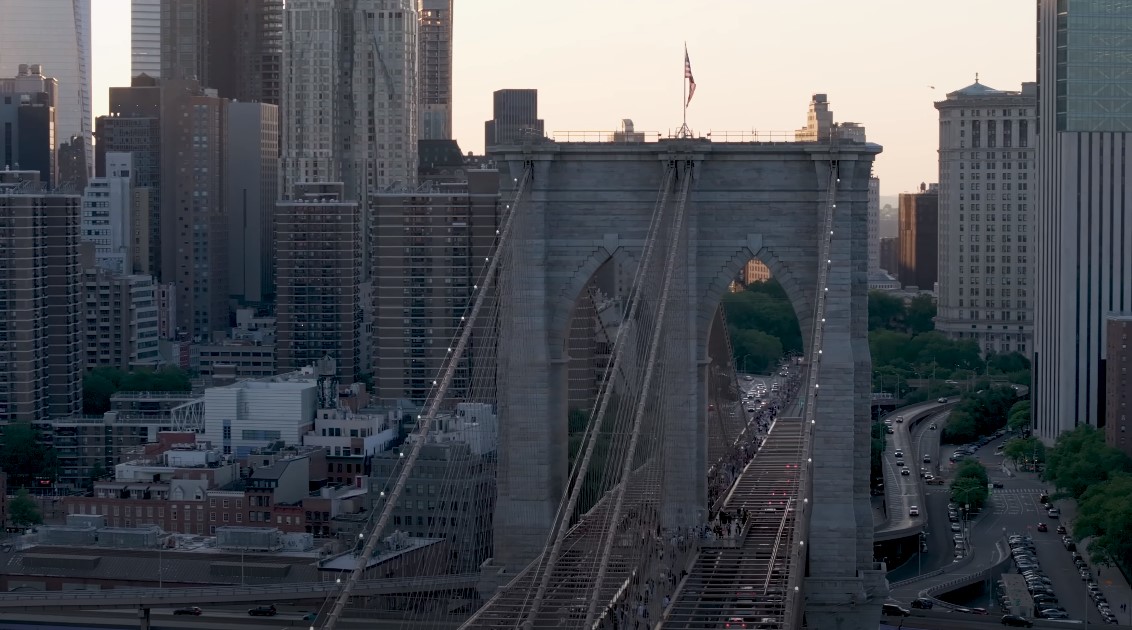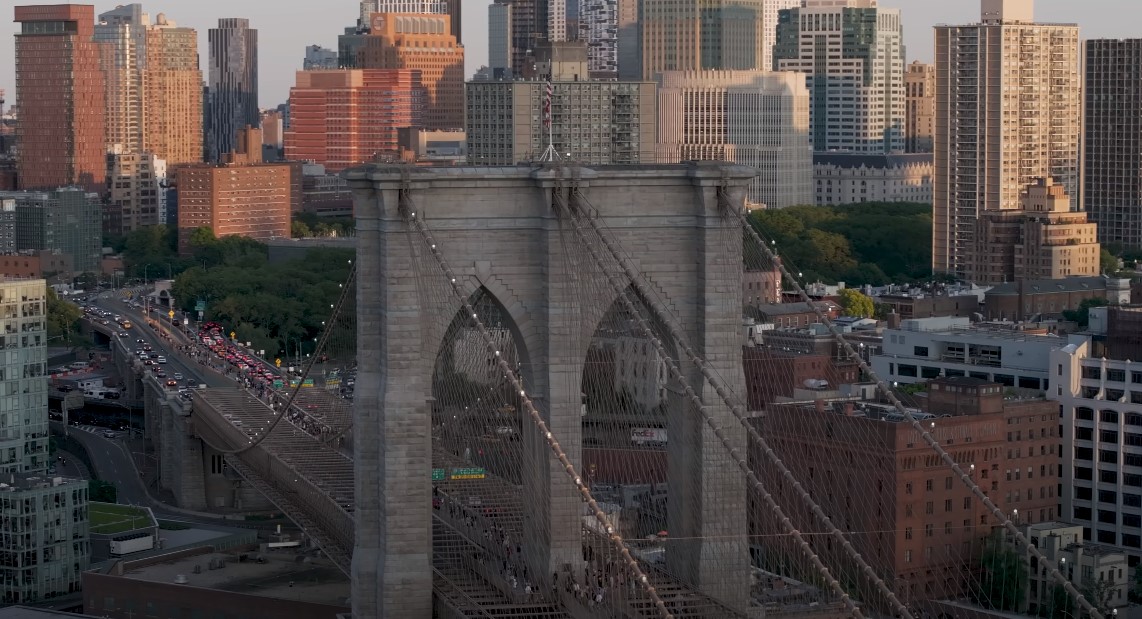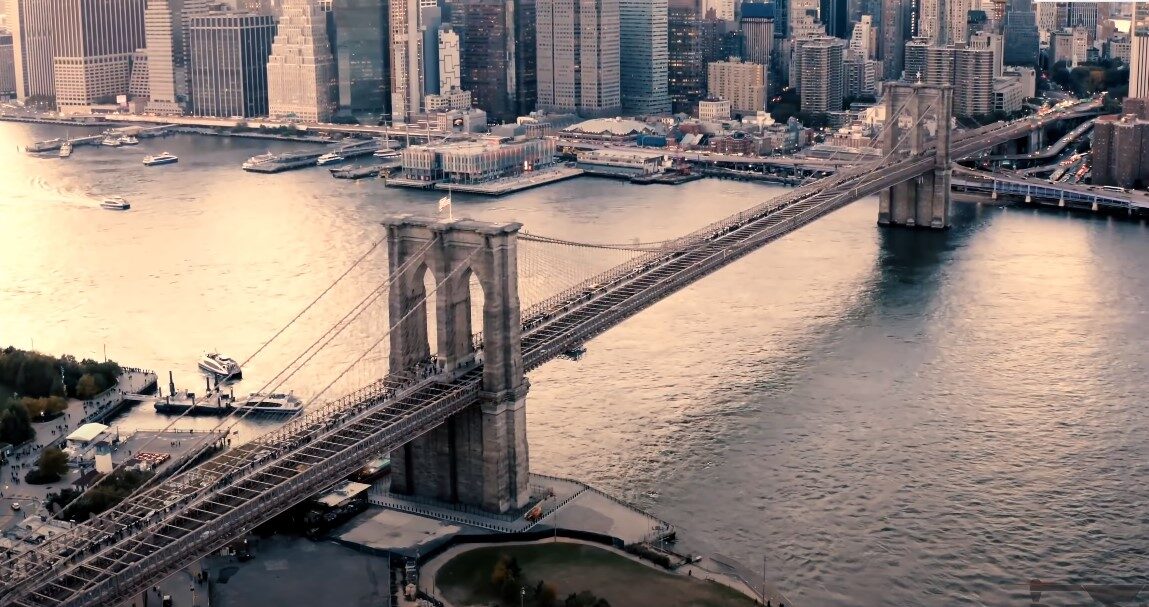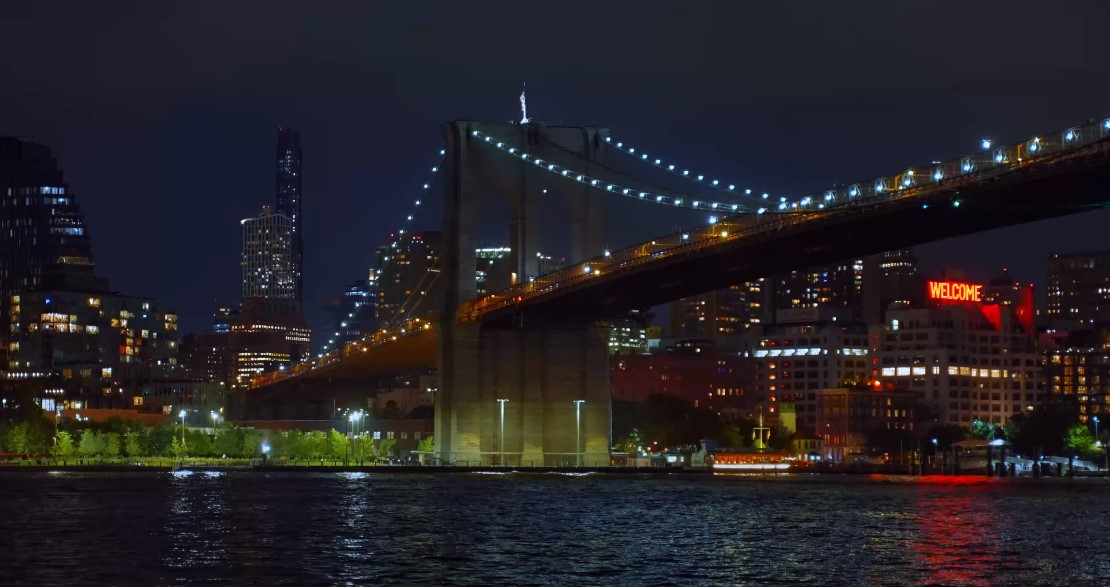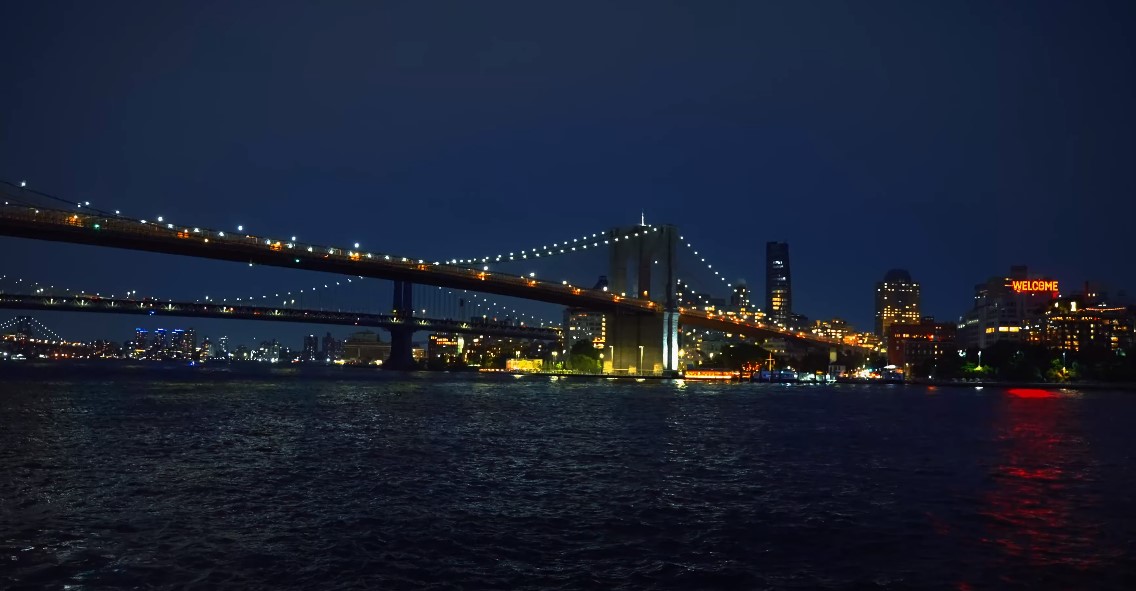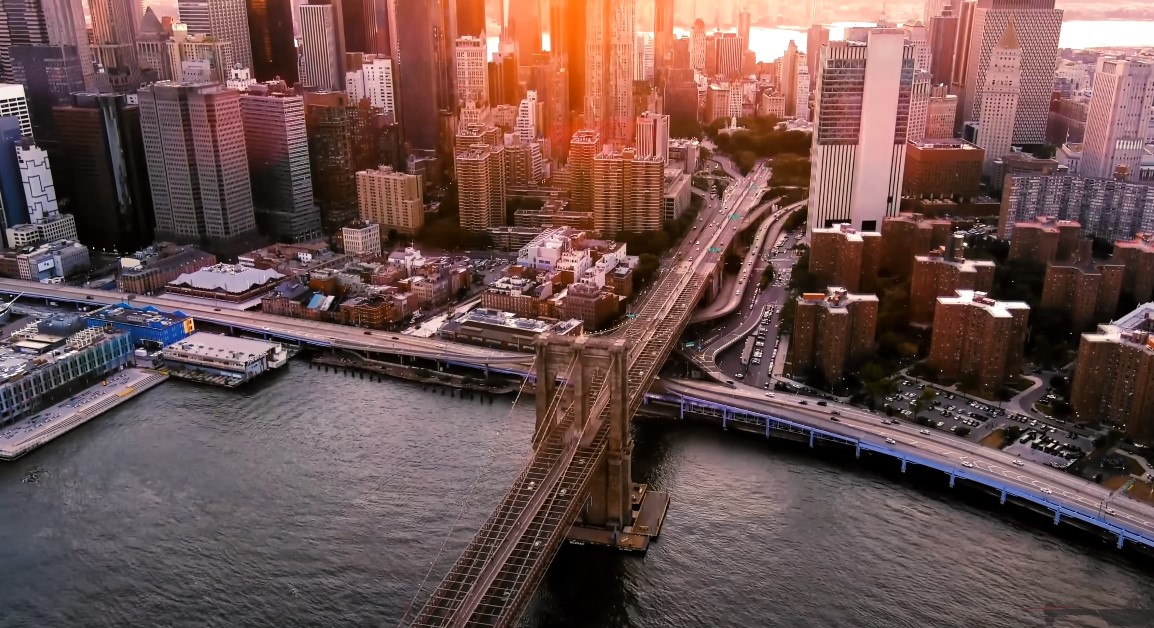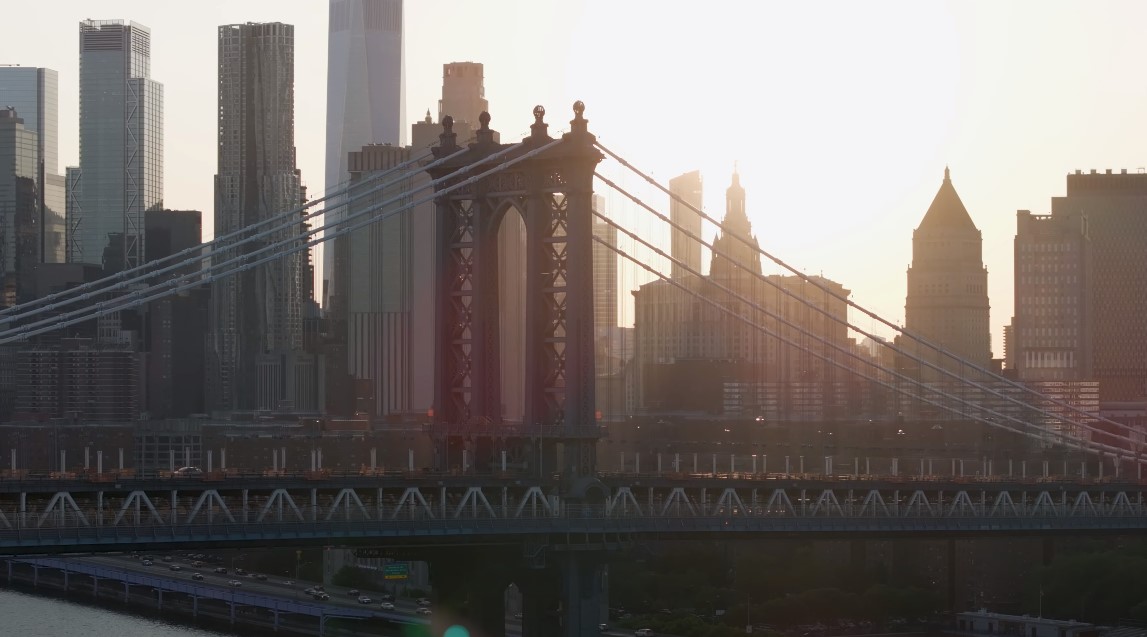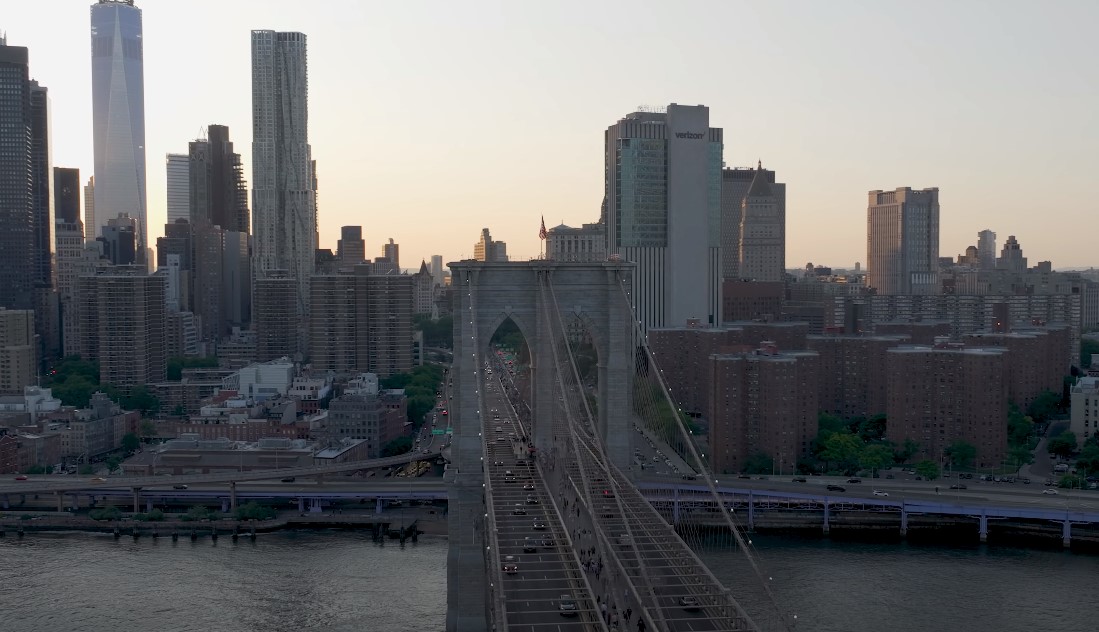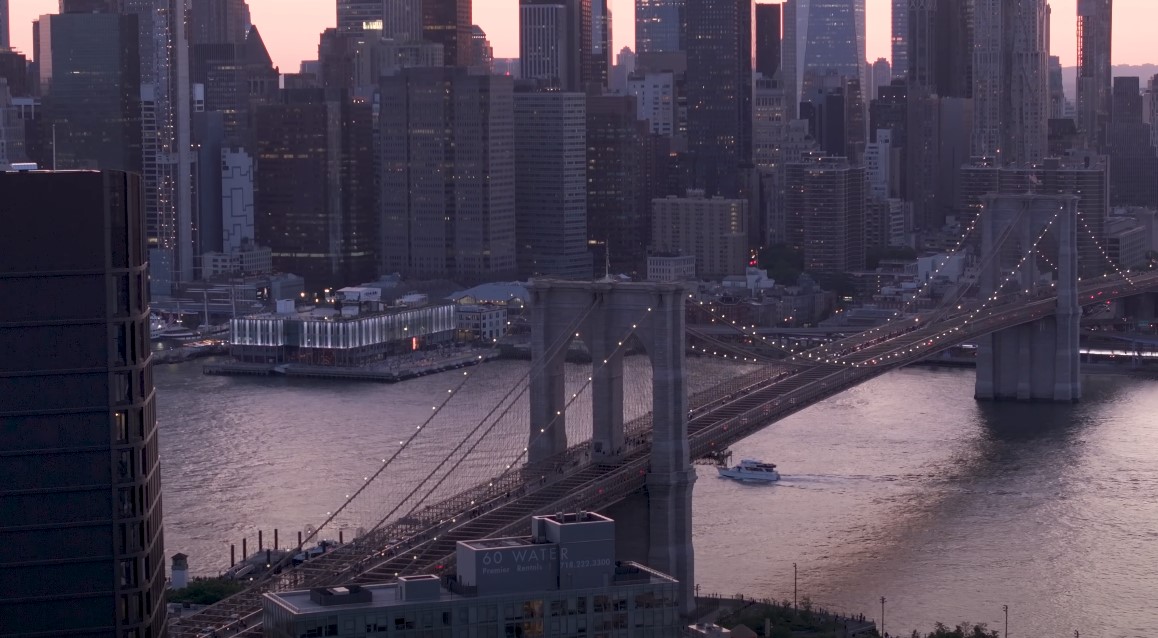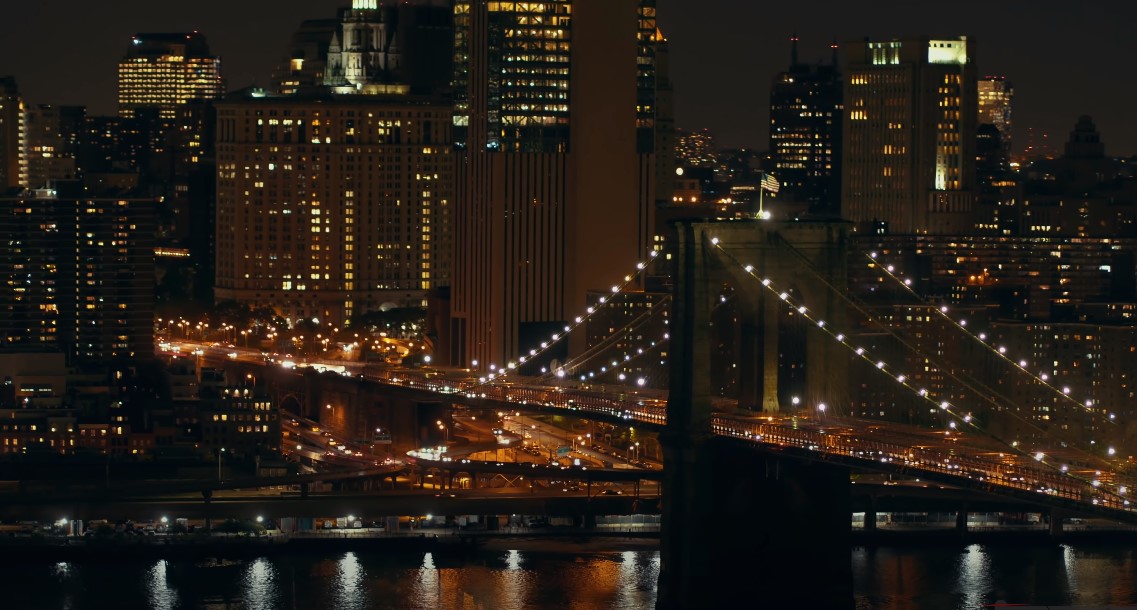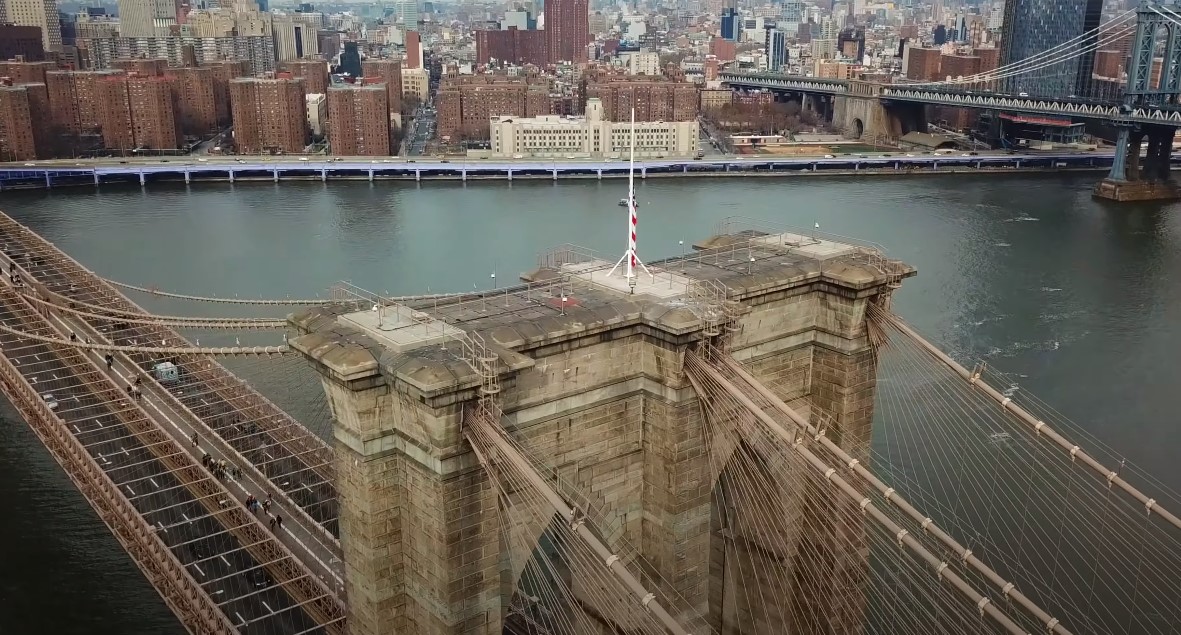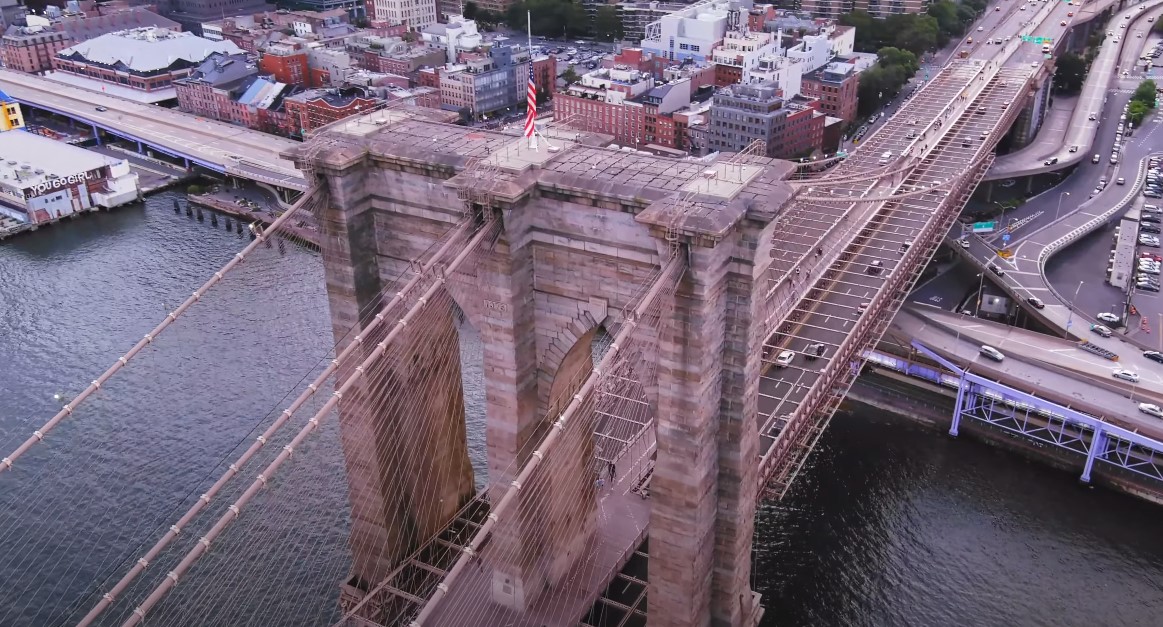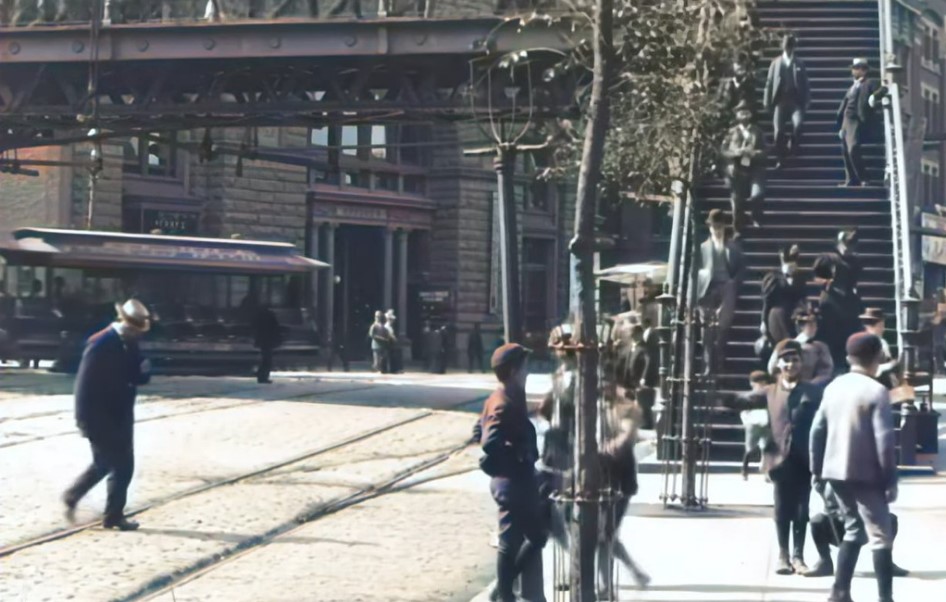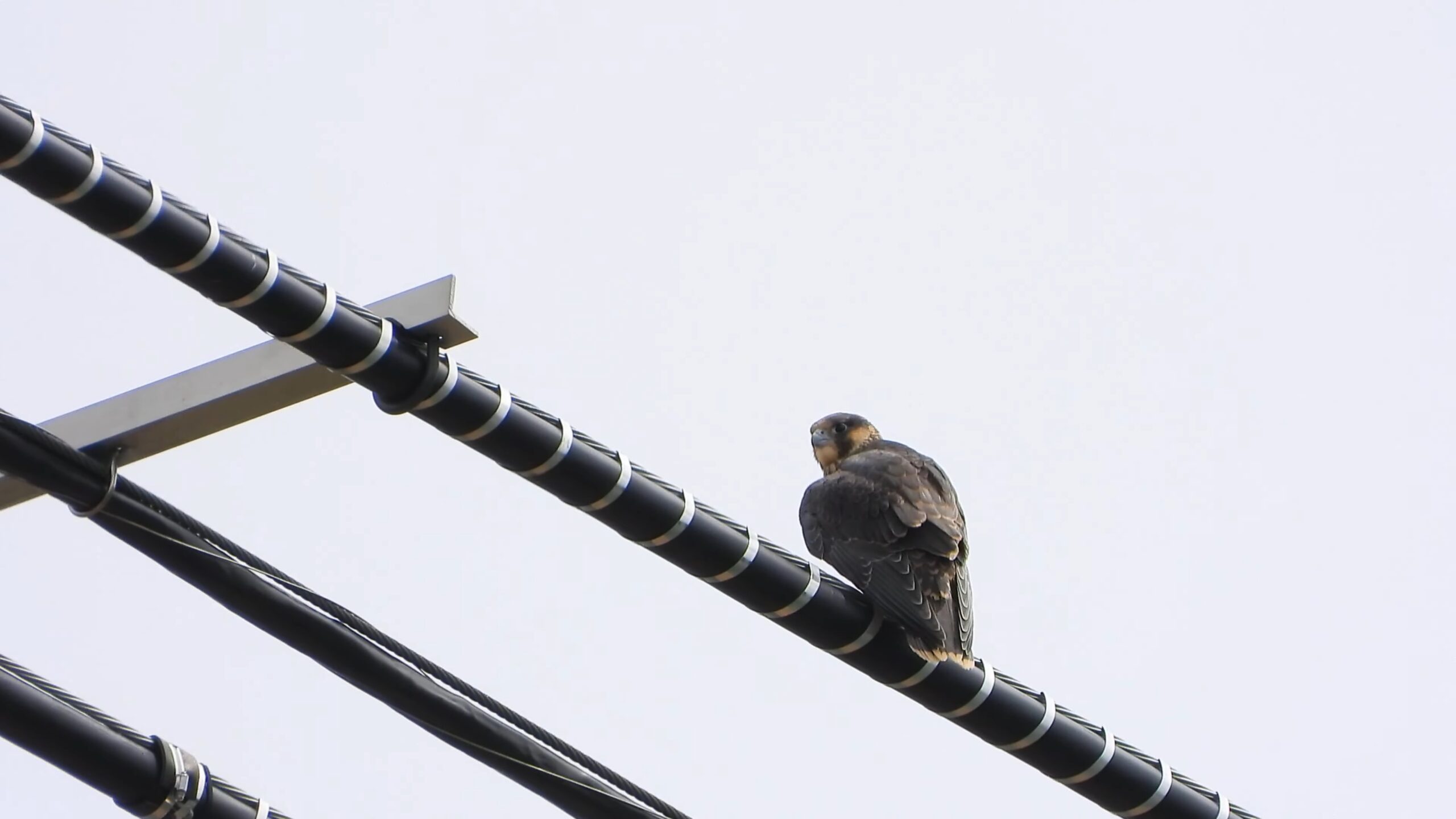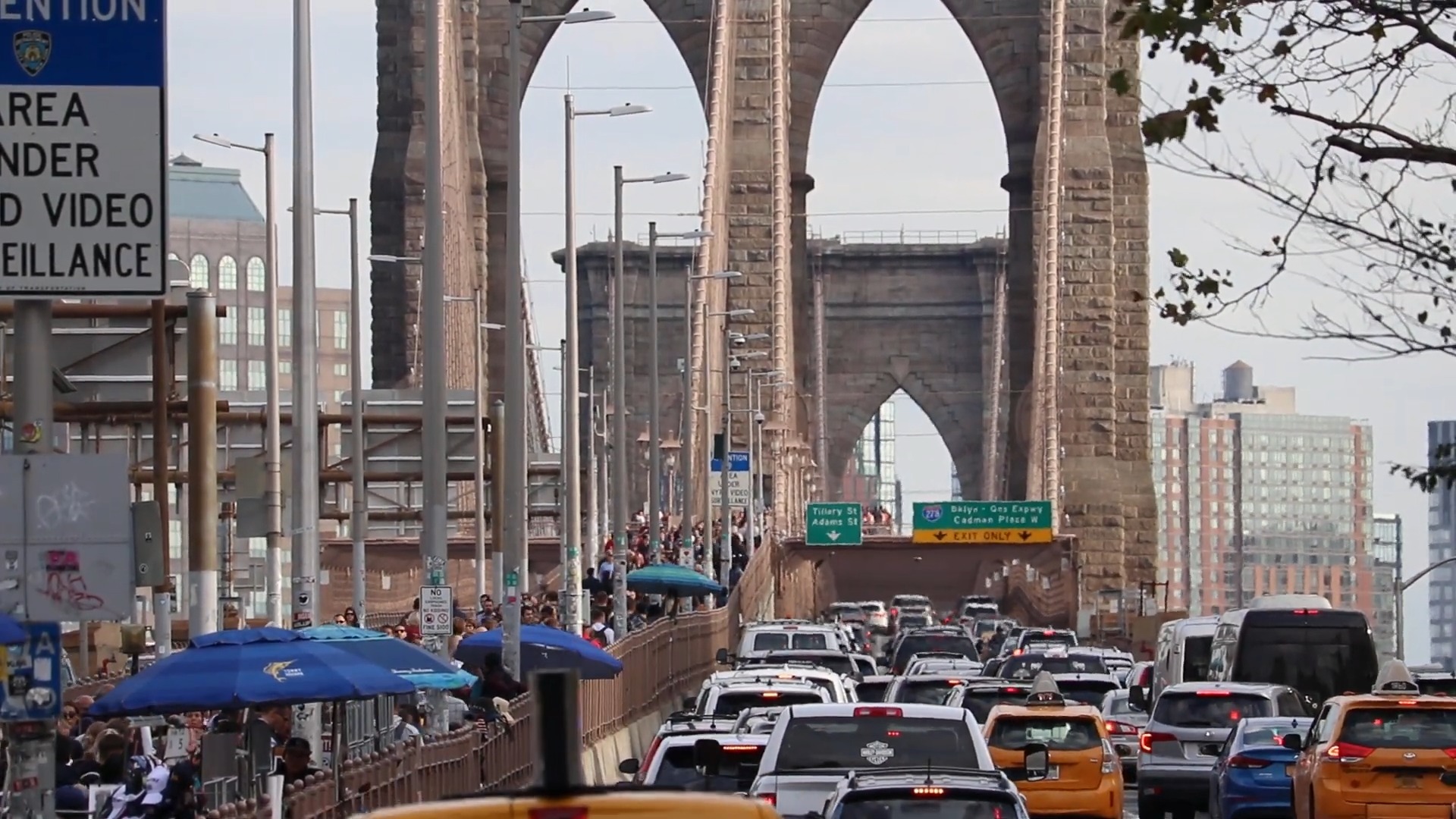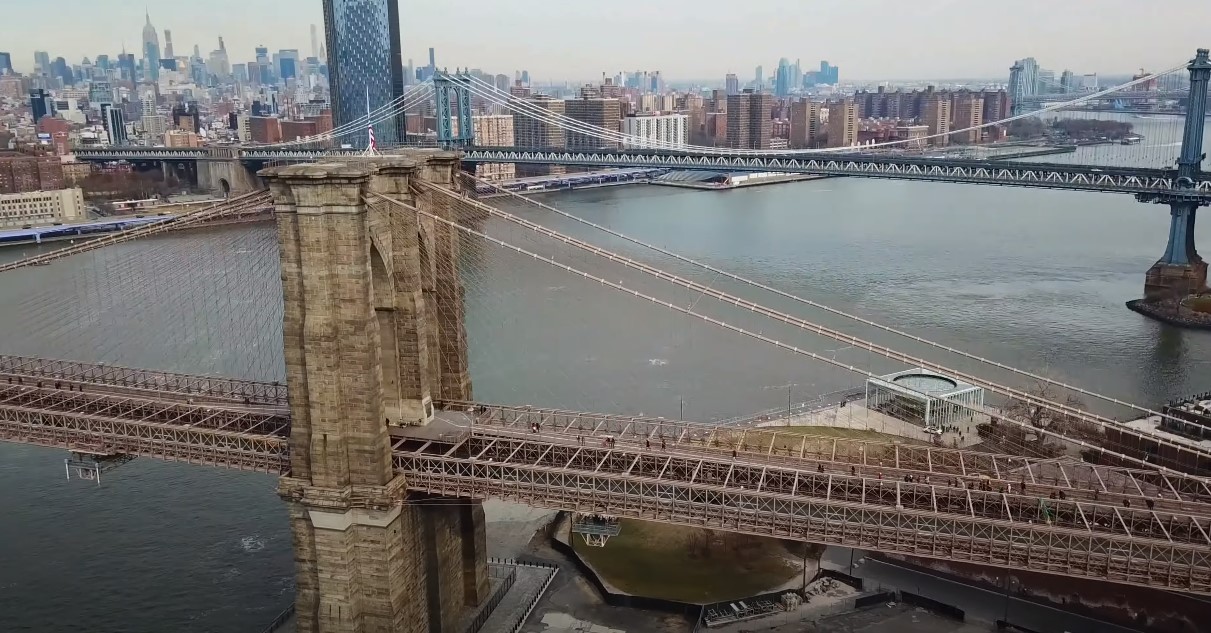Crossing the Brooklyn Bridge, whether for the first or the hundredth time, is an experience that consistently captivates me. Each walk, through every season and at various hours, whether solo or with companions, brings a unique charm that never wanes. The bridge, with its enduring allure, always manages to leave me in awe.
Yet, it’s intriguing how one can repeatedly embrace such an experience and still remain somewhat uninformed about its comprehensive history. On my most recent stroll across this iconic structure, it struck me that my knowledge of its origins and construction was, at best, superficial.
Embracing my inner geek and leveraging my adeptness at online research, I set out on a quest to unearth every intriguing detail about this celebrated New York City icon. And let me assure you, the fascinating tidbits I discovered about the Brooklyn Bridge are genuinely astounding!
Key Takeaways
- Construction was initiated by a bribe from William “Boss” Tweed.
- Its chief engineer, John A. Roebling, passed away before it was finished.
- Emily Warren Roebling stepped in, playing a key role in the bridge’s completion.
- The first steel-wire suspension bridge of its kind, completed in 1883.
- Over 600 workers contributed to its 14-year construction period.
- The location is known to be dangerous for thrill-seekers.
- The bridge’s history includes both remarkable achievements and tragic losses, with over 20 people dying during its construction.
- It houses a concealed bomb shelter.
-
A scam artist deceitfully sold the Brooklyn Bridge without actually owning it.
The Architectural Mastermind
John Augustus Roebling stands as the principal figure in the narrative of the Brooklyn Bridge’s genesis. Originating from Germany, his reputation as a civil engineer of acclaim was built upon his innovations in suspension bridge design. His educational journey, with a focus on bridge construction, laid the groundwork for what would become a storied career.
Roebling’s expertise was not confined to just one continent. Having contributed to several significant bridges across Europe, his ambitions carried him on to the United States. He brought with him a mission to overcome new engineering challenges. His work, which included bridges over the Niagara, Ohio, and Kentucky Rivers, was characterized by a relentless pursuit of engineering excellence.
When Roebling turned his talents towards the bustling city of New York, a groundbreaking vision began to unfold. The city’s vibrancy and the logistical need to connect Manhattan to Brooklyn set the stage for Roebling’s most daring project. Prior to this, the only means of connection was via ferry service, a limitation Roebling aimed to transcend with a bridge of unprecedented scope.
Although Roebling’s path was beset with trials, his tenacity remained a constant force, driving the project toward fruition. Tragically, Roebling would not witness the eventual triumphant completion of the Brooklyn Bridge. Nonetheless, his legacy is enduringly cemented in its steel wires and towering presence. The bridge not only serves as a practical passageway but also as an emblem of what ambition and fortitude can accomplish.
Key Contributors to the Brooklyn Bridge Construction
The creation of the Brooklyn Bridge was a result of the collective efforts of four pivotal figures:
- John Roebling: A German-born engineer whose innovative spirit and design expertise in suspension bridges were fundamental to the conceptualization of the bridge. It was his foresight and engineering skills that were crucial in setting the project in motion.
- William Tweed: Known as “Boss” Tweed, he was a powerful political figure in New York City. He played a pivotal role in acquiring the necessary finances to initiate the Brooklyn Bridge project, despite his notorious reputation for political corruption.
- Washington Roebling: After an unforeseen accident incapacitated John Roebling, his son, Washington, took the forefront as the Chief Engineer. His commitment to precision and his ingenuity in overcoming structural challenges were central to the bridge’s construction.
- Emily Warren Roebling: The unsung hero of this project was Washington’s wife, Emily. She was instrumental in the completion of the bridge, stepping in to assist when her husband could no longer fulfill his duties.
40 Facts You Probably Didn’t Know
1. Construction Started by William “Boss” Tweed’s Bribery
William Tweed, infamously known as “Boss” Tweed, exploited his influential political role to propel the Brooklyn Bridge project forward through corrupt means. Tweed, a master of manipulation within New York City’s political scene, leveraged his power to initiate the bridge’s funding through dishonest practices according to a source.
- Initiation of the Bridge Funding: Tweed channeled $65,000—now the equivalent of approximately $1.5 million—to the city’s aldermen to garner their approval for a crucial bond issue.
- Financial Gains: His ulterior motive was to bolster his financial position by becoming a major investor in the bridge and securing a spot on the committee responsible for the financial oversight of the project.
- Devious Schemes: Beyond initial investments, Tweed and his associates concocted plans to embezzle even more funds meant for the bridge.
Tweed’s avarice ultimately led to his arrest in 1871, preventing him from completely carrying out his plan and thus altering the course of the Brooklyn Bridge’s financial underpinnings.
2. The Bridge’s Architect Died Long Before It Was Finished
John Augustus Roebling, the chief engineer for the Brooklyn Bridge, faced a calamitous accident that resulted in severe injuries to his foot. During the preliminary work, a crash between a boat and the dock led to his foot being severely crushed.
Post-accident, the toes were amputated but a grave infection ensued. Roebling chose an unconventional treatment, applying water to the wound, which failed to stave off the infection. Sadly, his condition deteriorated, leading to his death from tetanus before the bridge was finished.
3. His Son Came Close to Death as Well
After the death of his father, Washington Roebling stepped into the role of Chief Engineer for the bridge. Unfortunately, Washington was soon afflicted by Caisson Disease, which left him bedridden due to paralysis.
Despite his physical limitations, he continued to oversee the completion of the bridge from a window in his home, using a telescope to maintain a watchful eye over the construction.
His wife, Emily Warren Roebling, became an essential conduit for communication. For over a decade, she faithfully relayed her husband’s instructions to the team, ensuring the project stayed on course.
4. The Bridge’s Role in Popular Protests and Public Demonstrations
Throughout its history, the Brooklyn Bridge has not only been a symbol of architectural innovation but also a focal point for social and political expression. It has hosted numerous significant protests and public demonstrations, reflecting the city’s vibrant activist spirit.
Notable instances include marches for civil rights, environmental causes, and labor union parades. This tradition underscores the bridge’s status as a public forum for voicing societal concerns and advocating for change.
5. Innovative Use of Pneumatic Caissons During Construction
The Brooklyn Bridge’s construction introduced the groundbreaking use of pneumatic caissons, large underwater structures used to build the bridge’s foundations. This technology allowed workers to excavate the riverbed in a pressurized environment, a novel method at the time according to StudySmarter.
The success of these caissons laid the groundwork for future underwater construction projects and represented a significant engineering achievement of the 19th century.
6. The Finalization of the Brooklyn Bridge Symbolized a Major Triumph for Women’s Rights
Emily Warren Roebling emerged as a central figure in the completion of the Brooklyn Bridge after her husband, Washington Roebling, was incapacitated by illness. She transcended the expectations of her era, taking over as the communicator and intermediary for the bridge project. Roebling’s tenacity and resourcefulness were instrumental in guiding the bridge to its final fruition.
- Trailblazing Role: Emily Roebling’s management of bridge construction
- Education: Obtained a law degree from NYU
- Advocacy: Became an influential proponent for women’s rights
7. The Building of the Bridge Spanned 14 Years and Involved More Than 600 Workers
- Time span: 1869 to 1883
- Duration: 14 years
- Workforce Involved: Over 600 personnel
Creation spanned over a decade, requiring the persistent labor of hundreds of individuals. A diverse team ranging from engineers to manual workers melded their expertise and dedication, overcoming significant challenges without modern equipment as highlighted by History.com. Their collective efforts during these years not only shaped an iconic structure but also a testament to human tenacity and ingenuity.
8. It Cost $15 Million To Construct
- Initial Expense: Approximately $15.5 million
- Today’s Equivalent: Close to $450 million according to the CPI Inflation Calculator
- Significance: A considerable outlay for advancing New York City’s transport network.
9. It Became the World’s First Bridge Suspended by Steel Wires
The Brooklyn Bridge, completed in 1883, holds the distinction of being the initial bridge globally to utilize steel wire for its suspension system reflecting in this Quora discussion.
Its novel approach involved:
- Anchoring and suspending steel wire cables between towering stone pillars.
- Providing exceptional durability and steadiness.
- Establishing new benchmarks for structural integrity.
This leap in engineering led to advancements in the construction of suspension bridges worldwide.
10. Construction Required More Than 14,000 Miles of Wire
The construction of the Brooklyn Bridge involved an extensive amount of wiring, where the structure’s stability is reliant on more than 14,000 miles of wire. The bridge is suspended by four massive cables, and each is composed of 5,282 intertwined steel wires with a diameter of nearly 15 inches according to the Bill of Rights Institute. These are not single-threaded wires but rather assembled from 19 strands each, further broken down into 278 individual wires per strand.
Workers undertook the meticulous task of splicing these wires under hazardous conditions and often adverse weather. The wire strands were painstakingly joined before being transported across the East River.
The assembly of these cables was not a swift process; the teams dedicated close to two years to weave the complex cable system that would come to define the Brooklyn Bridge’s iconic silhouette.
11. The Bridge’s Structural Integrity Was Nearly Jeopardized by a Wire Supplier
The Brooklyn Bridge faced a serious challenge when J. Lloyd Haigh, a wire supplier, attempted to cheat by introducing subpar material.
- Quality Control: Inspectors were initially positioned at Haigh’s factory to verify the quality of the wire, on a per-wagon basis, for the bridge’s construction.
- Deception Detected: Despite these precautions, Haigh and his accomplices managed to switch the high-quality wire with inferior ones during transport.
- Roebling’s Foresight: Fortunately, Roebling had designed the bridge’s cables with significant safety tolerances, predicting such fraudulent activities could occur.
- Decision: In an unexpected move, Roebling permitted the integration of the lower-grade wire into the bridge, relying on his initial safety calculations.
12. Construction Resulted in the Deaths of Almost 30 Workers
The construction of the Brooklyn Bridge was marred by the loss of nearly 30 workers’ lives under various tragic circumstances. These individuals faced multiple risks, including:
- Falls: Some workers plummeted from the soaring heights of the 276-foot towers or the suspension wires.
- Crushing Accidents: A number encountered fatal injuries due to debris descending unexpectedly.
- Caisson Disease: Also known as “the bends,” affected several laborers, leading to fatalities.
The project’s scale and the era’s modest safety measures significantly contributed to these hazards.
13. Over 100 Workers Experienced Permanent Effects from Caisson Disease
During the construction of the Brooklyn Bridge, workers found themselves operating deep underwater in the protective confines of wooden enclosures termed caissons. These structures, fixed to the riverbed and blocked off by enormous granite weights, contained pressurized atmospheres to repel water and detritus.
Though slight symptoms such as headaches, skin rashes, and nosebleeds were common among the submerged laborers, it was the transitions to and from these underwater boxes that presented serious hazards. The descent into the murky depths involved passage through airlocks filled with compressed air to facilitate breathing and counteract the enveloping water pressure.
Regrettably, this act of breathing under pressure left the workers’ bodies saturated with inert gases—a condition that upon surfacing resulted in the rapid formation of gas bubbles within their tissues. The medical community recognizes this disorder as Decompression Sickness or “The Bends,” marked by excruciating muscle and joint pain, disturbed bladder function, skin rashes, severe abdominal discomfort, numbness, paralysis, and instances of mortality.
Over a century’s count of laborers emerged from the construction site bearing irrevocable harm from the effects of this ailment, with some facing lifelong disability as a consequence.
14. Structure Towers at More Than 276 Feet in Height and 85 Feet in Width
The Brooklyn Bridge proudly soars at a height of 276.5 feet, comparable to the stature of a 25-floor structure, and spans 85 feet in width. This significant breadth accommodates the daily flow of vehicles, cyclists, and pedestrians that cross the historic expanse.
15. It Initially Connected Two Different Cities
- Brooklyn and New York City: Separate entities
- Consolidation: Occurred in 1898
16. Neo-Gothic Elegance
The Brooklyn Bridge showcases a distinct Neo-Gothic style, mirroring European cathedrals’ grandeur. The design features:
- Stone construction
- Pointed arches
- Ornamental detailing
These elements combine, embodying the bridge’s aesthetic dignity and sophistication.
17. Name “Brooklyn Bridge” Was Not Its Original Moniker
The bridge connecting Manhattan and Brooklyn was not always known as the Brooklyn Bridge. In the early stages, it was called the “Great East River Bridge” and at its dedication in 1883, it went by “New York and Brooklyn Bridge.” The iconic name “Brooklyn Bridge” was officially adopted in 1915 according to World Atlas.
18. Its Span Reaches Beyond a Mile from One Terminus to the Other
Bridge stands as a testament to architectural achievement, with its length reaching 1.14 miles from one end to the other. Pedestrians and cyclists traversing the bridge should note the journey totals approximately 1.6 miles, factoring in the paths leading onto and off the structure.
- Full length: 1.14 miles (1.83 kilometers)
- Total travel distance: 1.6 miles (2.6 kilometers)
19. It Held the Title of the World’s Longest Suspension Bridge for Two Decades
- Opened: 1883
- Main Span: 1,595 feet (486 meters)
- Record Held: 1883-1903
- Surpassed by: Williamsburg Bridge at 1,600 feet (487 meters)
20. A Swindler Falsely Sold the Brooklyn Bridge, Despite Not Owning It
In the annals of American con artists, George C. Parker’s schemes are particularly brazen. He notoriously duped people into buying what they thought was the Brooklyn Bridge.
Parker’s swindles involved crafting counterfeit deeds and assuring riches to the unknowing victims who thought they were getting a piece of this iconic landmark.
I just don’t understand how could someone sell such a giant thing to pedestrians, this still intrigues me.
Notable Aspects of Parker’s Cons:
- Fake Ownership Papers: Parker’s forged deeds seemed legitimate to buyers.
- Illusory Profit: The promise of future toll collections enticed victims.
His con went on unchallenged until 1928 when repeated fraud convictions sent him to serve a life sentence at Sing Sing Correctional Facility. His legacy remains a cautionary tale in American folklore.
21. A Rooster Took Part In The Historic Inaugural Crossing
Emily Roebling acknowledged for her pivotal role in the construction of the Brooklyn Bridge, was the first to traverse the bridge before its official opening. Her journey from Brooklyn to Manhattan was made in a carriage pulled by horses.
In a gesture of optimism and triumph, she cradled a rooster during her historic ride across the bridge.
22. Over 150,000 People Crossed the Bridge on Its Highly Anticipated Opening Day
On its momentous first day, May 24, 1883, the Brooklyn Bridge hosted a remarkable event as over 150,000 individuals streamed across its expanse. The occasion saw notables such as President Chester A.
Arthur and future president Grover Cleveland in attendance, marching alongside a robust military presence and to the sounds of a band.
Key Details:
- Date: May 24, 1883
- Notable Figures: President Chester A. Arthur, Governor Grover Cleveland
Celebrations Included:
- Military processions
- Cannon salutes
- Speeches
- Fireworks display in the evening
The public was eager to traverse the new architectural marvel, flocking in droves and turning the event into a festive demonstration of civic pride. This moment served as a significant chapter in the history of New York City.
23. Tragically, The Grand Opening Was Overshadowed by Disaster
Within days of its ceremonial debut, the Brooklyn Bridge became the site of chaos. Misinformation caused a mass of 20,000 visitors to believe the structure was failing, triggering a catastrophic scramble.
The resulting turmoil led to the deaths of a dozen individuals by trampling, with numerous others sustaining severe injuries.
24. An Elephant Parade Featuring 21 Elephants Once Marched Across It
- Date: May 17, 1884
- Event: Elephant Parade
- Led by: P.T. Barnum
- Notable Elephant: Jumbo
- Purpose: To prove bridge’s stability
To assuage public concerns about the Brooklyn Bridge’s solidity, showman P.T. Barnum led a remarkable procession. This included 21 elephants, with the famous Jumbo among them, and 17 camels. Their journey across the structure was safe, showcasing its robust build to the onlookers.
25. Crossing Once Required Paying a Toll Fee
Once, crossing the iconic Brooklyn Bridge had its costs.
Fees for passage varied by traveler:
- Humans: 1 cent
- Swine and Sheep: 2 cents
- Equestrian: 5 cents
- Bovine: 5 cents
- Horse-Drawn Carriages: 10 cents
The year 1891 marked the end of this era, ushering in toll-free access for everyone.
26. Hidden Wine Cellars Were Constructed Within Its Anchorages
- Location: Inside Brooklyn Bridge’s anchorages
- Function: Wine storage
- Time Period: Pre-World War I era
- Conditions: Ideal due to cool granite
- Height: Approximately 50 feet
Cost for Rent:
- Brooklyn vaults: $500/month by A. Smith & Co. Productions
- Manhattan vaults: $5000/month by Luyties Brothers
27. It Was Built Before London’s Tower Bridge
- Brooklyn Bridge completion: 1883
- Tower Bridge completion: 1894
- Span difference: Brooklyn Bridge is 11 years older
28. It Measures Shorter in Length Compared to the Manhattan Bridge
Manhattan Bridge:
- Length: 6,090 feet / 1.15 miles
- Meters: 1856 / 1.85 kilometers
Brooklyn Bridge:
- Length: 6,016 feet / 1.14 miles
- Meters: 1,834 / 1.83 kilometers
Spanning the East River, the Manhattan Bridge’s stretch exceeds its neighbouring Brooklyn Bridge by a measure of 74 feet. A notable difference, considering both serve as historical thoroughfares in New York City.
29. The Site of the Brooklyn Bridge Was Once a Sleeping Place for the United States’ First President
Where the Brooklyn Bridge now connects two boroughs, stands a site steeped in presidential history. George Washington called this location home in the late 18th century.
The Samuel Osgood House, at Cherry and Pearl Streets, was where he resided during his early presidency from April 1789 until February 1790. Although the building does not exist today, demolished in 1856, a bronze plaque on the bridge’s Manhattan anchorage honors its historical significance.
30. It Became A Cultural Phenomenon In No Time
The Brooklyn Bridge swiftly ascended to become a quintessential emblem of New York City. Its distinguished form has graced an array of creative works, inspiring film directors, musicians, visual artists, and authors.
Here’s a glimpse of its cultural footprint:
- Music: Legends like Frank Sinatra to contemporary bands like The Black Eyed Peas have paid homage in their tunes.
- Art: Renowned painters including Georgia O’Keeffe and pop art icon Andy Warhol have captured its essence.
- Literature: Noted writers from Henry Miller to Jack Kerouac have penned works mentioning this architectural marvel.
31. It Is Recorded on the National Register of Historic Places
- Designation Date: October 15, 1966
- Registry: National Register of Historic Places
- Significance: Architectural and historical importance
32. It Has Been Designated as a National Historic Landmark
- Year of Designation: 1964
- Criteria: Exceptional historical and cultural value
- Comparison: Distinct among the top 3% of National Register of Historic Places
The Brooklyn Bridge stands out as a National Historic Landmark due to its distinguished historical and cultural significance within the United States.
33. Furthermore, It’s Recognized as Both a New York City Landmark and a National Historic Civil Engineering Landmark
Recognized both for its significance and aesthetics, the Brooklyn Bridge proudly holds the status of a New York City Landmark. This designation is a testament to its integral role in the city’s historical and cultural narrative.
Designation by American Society of Civil Engineers:
- Year: 1972
- Title: National Historic Civil Engineering Landmark
The bridge’s recognition by the American Society of Civil Engineers places it among a prestigious group of structures acclaimed for their exceptional contribution to civil engineering and society on local, national, and international stages. This honor celebrates the bridge’s enduring legacy in architectural achievement.
34. It Contains A Hidden Bomb Shelter
In 2006, maintenance crews on the Brooklyn Bridge stumbled upon an unexpected relic of the Cold War—a secret bomb shelter according to the New York Times. Nestled within the bridge’s Manhattan anchorage, the shelter was stocked with Cold War essentials:
- Medical supplies for emergencies
- Blankets to combat the cold
- Drugs designed to mitigate shock
- Drums of water for hydration
- A substantial stockpile of crackers (352,000 packets)
35. Sometimes It Is 3 Inches Taller Than Usually
The Brooklyn Bridge’s ability to change its height by up to three inches due to temperature effects truly fascinates me. Learning that cold weather can make the steel cables contract, raising the bridge slightly, while warm weather causes them to expand, lowering it back, highlights the incredible interplay between engineering and nature proven in this study.
This dynamic characteristic of the bridge not only showcases the ingenuity behind its design but also reminds me of the adaptability required in creating structures that endure through changing conditions. It’s amazing to think about how even monumental constructions like the Brooklyn Bridge respond to the environment around them, much like living organisms.
Temperature Effects:
- Cold Weather: Cables shorten, bridge elevation increases.
- Warm Weather: Cables lengthen, bridge returns to its usual position.
This thermal response of the bridge’s steel wires results in a notable height change, at times measuring up to three inches.
36. The Original Color of the Bridge is “Brooklyn Bridge Tan” (Though This Detail is Subject to Much Debate)
The color known as “Brooklyn Bridge Tan” is acknowledged as the bridge’s initial shade, yet this point has seen considerable discussion. Some contend that “Rawlins Red” was the bridge’s first color, named after a red iron oxide sourced from Rawlins, Wyoming. Despite this contention, most agree and the Landmarks Preservation Commission has endorsed “Brooklyn Bridge Tan” as the bridge’s authentic and formal color, celebrated for its warm tone.
37. It Has Proven to Be a Perilous Spot for Daredevils
The Brooklyn Bridge has long been a magnet for those testing the extremities of bravery. Unfortunately, these stunts can end in tragedy.
- 1885: The bridge claimed the life of swimming instructor Robert E. Odlum, who sought to make history by jumping from it. His venture ended fatally, serving as a solemn reminder of the bridge’s perilous allure for daredevils.
38. Peregrine Falcons Have Made the Brooklyn Bridge Their Habitat
Above the Brooklyn Bridge, the stately stone towers serve as residences for Peregrine Falcons. These birds, once on the brink of disappearing due to harmful pesticides, are now a common sight, thanks to the protections afforded by the 1973 Endangered Species Act. Their numbers have flourished, and they contribute significantly to managing the local pigeon and bird populations.
- Conservation Efforts: MTA Bridges and Tunnels actively support these birds by installing and maintaining special nesting boxes.
- Urban Adaptation: The falcons have adapted well to city life, choosing towering structures like bridges and skyscrapers to settle down.
39. Every Day, 149,000 Pedestrians and Vehicles Traverse the Brooklyn Bridge
The Brooklyn Bridge sees a significant amount of daily traffic, comprising a diverse mix of cars, pedestrians, and cyclists. Every day, an array of vehicles and individuals utilize this historic structure to traverse the East River.
- Vehicles: Over 116,000
- Pedestrians: Around 30,000
- Cyclists: Approximately 3,000
This daily flow underscores the bridge’s role as a crucial artery for New York City’s transportation network, connecting Manhattan and Brooklyn for various purposes, from commuting to leisure.
When I visited the Brooklyn Bridge, the experience was unforgettable. Walking among this much pedestrians, I felt part of a massive, moving community.
40. Film and Literature as a Symbol of Unity and Transition
The Brooklyn Bridge, with its grandeur and historical significance, has been a prominent symbol in film and literature, often representing the themes of unity, transition, and the passage of time. Its portrayal varies across narratives, capturing the essence of New York City’s dynamism and the bridge as a connecting point between diverse experiences and locales. Here are notable examples of how the Brooklyn Bridge has been featured in movies, showcasing its symbolic role:
“Saturday Night Fever” (1977)
- Context: The Brooklyn Bridge serves as a backdrop in several scenes, symbolizing the protagonist’s, Tony Manero’s, desire to escape the confines of his Brooklyn life for the broader possibilities that Manhattan represents. The bridge visually encapsulates Tony’s dreams of change and personal transformation.
- Symbolism: Transition and aspiration.
“Moonstruck” (1987)
- Context: The bridge features prominently in this romantic comedy, highlighting the characters’ emotional journeys. It stands as a metaphor for the connections between different aspects of their lives, bridging the gap between their past struggles and future hopes.
- Symbolism: Love, connection, and renewal.
“Spider-Man” (2002)
- Context: In a pivotal scene, Spider-Man faces a moral dilemma on the Brooklyn Bridge, highlighting his responsibility to the city and its people. The bridge acts as a stage for heroism and personal challenge, emphasizing the character’s role in bridging the safety of individuals with the greater good of society.
- Symbolism: Heroism, sacrifice, and protection.
“Brooklyn” (2015)
- Context: While not directly featuring the Brooklyn Bridge, the film’s title and narrative essence resonate with the bridge’s symbolism. It represents the protagonist’s journey from Ireland to Brooklyn, her experiences of love, loss, and the eventual bridging of her two worlds.
- Symbolism: Transition, belonging, and identity.
Engaging Insights
Exploring the vast cityscape of New York, one might discover more than just architectural wonders like the Brooklyn Bridge. There are a plethora of experiences waiting around each corner, ready to enrich your knowledge and appreciation of the city.
The Functionality of NYC’s Water Towers
Contrary to misconceptions, water towers in New York City are not just relics of the past; they play a crucial role in the city’s water distribution system. Ensuring adequate water pressure to the city’s many high-rise buildings, these structures are as essential today as they were in the past.
- Purpose: Maintaining water pressure for buildings
- Today’s Role: Integral to NYC’s water system infrastructure
- Common Misunderstanding: Not merely historical artifacts
Meander Through Central Park’s Bethesda Arcade
The Bethesda Arcade is another gem within New York’s iconic Central Park. Its elegant arches and tiled murals offer a picturesque escape from the bustling city streets and provide a walkway rich in art and history.
- Highlight: Mosaic art on the ceiling, known as the Minton tiles
- Experience: A blend of nature and artistry
- Location: Central Park’s heart
Little Island New York
Little Island is New York City’s newest addition to its public park collection. Floating on the Hudson, this park provides a refreshing retreat with unique architectural features and lush landscapes.
- Opening: Offers innovative outdoor space
- Design: Architectural novelty with undulating forms
- Visiting: A tranquil haven amidst urban surroundings
In the midst of New York City’s fast-paced environment, historical and modern structures like the Brooklyn Bridge, the functional water towers, the Bethesda Arcade, and Little Island provide a multi-layered experience, reflecting the city’s dedication to preserving its history while embracing innovation.
FAQ
Final Words
A testament to architectural brilliance, a beacon of connection, and a gateway to the dynamic worlds of Brooklyn and Manhattan, the Brooklyn Bridge embodies the enduring essence and vibrancy of New York City.
I trust these intriguing insights into the Brooklyn Bridge have enlightened you and deepened your appreciation for this monument to human creativity and perseverance!
Disclaimer
All information presented in this text is based on our own perspectives and experiences. The content is provided for informational purposes only and is a reflection of the personal views of the authors. It should not be taken as professional advice, nor should it be used as a basis for making significant decisions without consulting a qualified expert. We do not guarantee the accuracy or reliability of the information provided and shall not be held responsible for any inaccuracy, omissions, or inaccuracies. We highly recommend consulting with a qualified expert in the relevant field for personalized guidance or advice specific to your situation

